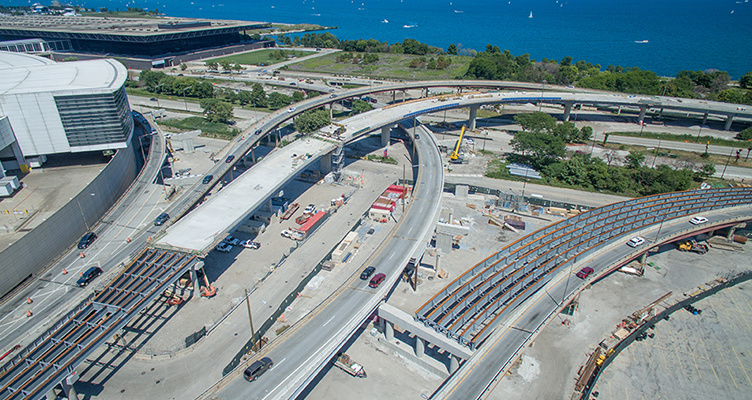- Details
 Illinois is home to one of the nation’s best workplaces for manufacturing and production, according to a new report from Fortune magazine.
Illinois is home to one of the nation’s best workplaces for manufacturing and production, according to a new report from Fortune magazine.
Fona International, a Geneva-based food and beverage manufacturer, ranks third on Fortune’s 2018 list of “The 20 Best Workplaces for Manufacturing and Production.”
Founded in 1987, Fona employs more than 200 people in Illinois. Among Fona employees, 96 percent say the company is a great place to work.
Fortune’s rankings are compiled by surveying employees from companies throughout the country on their experiences in the workplace.
- Details
 The Illinois Department of Transportation (IDOT) has earned the Grand Prize in the 2018 America’s Transportation Awards, the top honor for state departments of transportation. The award was presented to IDOT at the American Association of State Highway Transportation Officials annual meeting in Atlanta this week.
The Illinois Department of Transportation (IDOT) has earned the Grand Prize in the 2018 America’s Transportation Awards, the top honor for state departments of transportation. The award was presented to IDOT at the American Association of State Highway Transportation Officials annual meeting in Atlanta this week.
IDOT’s Interstate 55-Lake Shore Drive interchange took the top prize in the “Best Use of Technology & Innovation, Medium Project,” prize for its use of a temporary bridge to accommodate inbound I-55 traffic to southbound Lake Shore Drive.
“We are proud to bring this award home to Illinois for the first time,” Illinois Transportation Secretary Randy Blankenhorn said in a press release. “The innovation that made this project stand out represents IDOT’s enthusiasm and commitment for creating and maintaining a safe and efficient transportation system for travelers statewide. Our employees strive to find creative solutions each and every day in everything they do to keep Illinois moving.”
The project saves the public countless hours of delays by avoiding extended closures and detours during the reconstruction. It also increases safety, reduces congestion and connects a major interstate and an urban expressway near some of Chicago’s most popular recreational and educational destinations, according to IDOT.
The 2018 competition attracted 79 project nominations from state departments of transportation in 35 states. An independent panel of industry judges selected the Grand Prize winner, while the project receiving the highest number of online votes earned the Socrata People's Choice Award.
The award also included a $10,000 cash prize for a local nonprofit organization, which IDOT will give to the Special Olympics.
- Details
 Northwestern Memorial Hospital has once again been named among the best hospitals in the nation, according to the newest ranking from U.S. News & World Report.
Northwestern Memorial Hospital has once again been named among the best hospitals in the nation, according to the newest ranking from U.S. News & World Report.
The Chicago-based hospital was the only Illinois hospital to land in the top 20 hospitals in the country, receiving the 13th spot for the second year in a row.
U.S. News ranks hospitals across the country on the ability to deliver the highest quality of care across a range of specialties, procedures and conditions. Specifically, hospitals are ranked on a number of factors including survival and readmission rates, patient experience, patient safety and nursing quality, among other measures.
“U.S. News Best Hospitals rankings of Northwestern Medicine is a direct reflection of our relentless pursuit of better medicine,” said Dean M. Harrison, president and chief executive officer of Northwestern Memorial HealthCare said in a press release. “As Chicago’s premier academic health system, we are proud of our talented physicians, exceptional nurses and dedicated staff who collaborate each day to provide world-class care to the patients we are privileged to serve.”
- Details
 Decatur was recently named as the best metro area in the country for jobs in agriculture by Business Facilities Magazine.
Decatur was recently named as the best metro area in the country for jobs in agriculture by Business Facilities Magazine.
The national publication ranked American cities in a variety of areas that include solar energy, economic growth potential and cost of living. The magazine also based their ranking on agricultural feedstock employment leaders from the 2018 Biotechnology Innovation Organization report.
The city has twice the number of people employed in the feedstock and biosciences subsector compared to Houston, Texas and three times that of Chicago.
Decatur is also home to global companies like ADM, one the world’s largest agricultural processors and food ingredient providers, and Tate & Lyle, a multinational agribusiness.
To see the full list of rankings, click here.
- Details
 According to the latest ranking by U.S. News and World Report, 13 Illinois High Schools have been named among the best in the nation.
According to the latest ranking by U.S. News and World Report, 13 Illinois High Schools have been named among the best in the nation.
The rankings analyzed more than 20,500 public high schools across the country and 13 of Illinois’ public high schools received gold medal ratings. Gold medals were awarded to the top 500 schools, silver medals were given to the schools ranked between no. 501 and no. 2,711 and bronze medals were given to an additional 3,237 schools.
More Articles …
- NASA inducted Pekin native Captain Scott Altman into the U.S. Astronaut's Hall of Fame
- Illinois ranks 5th in net tech jobs
- 37 Illinois hospitals named safest in the country
- Chicago Amazon Prime members now have access to car delivery service
- O-Hare and Midway international airports to offer unlimited free Wi-Fi



